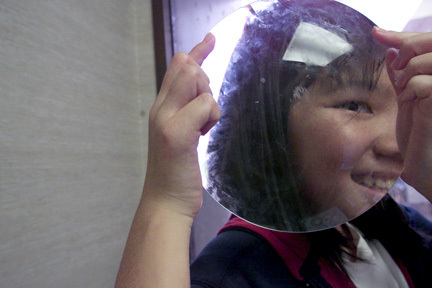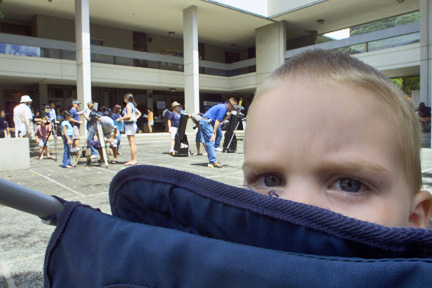
|
Seeing stars
UH astronomers give a brief tour
of the cosmos to 1,000 guests
With pieces of pink and yellow construction paper, Kaneohe's 12-year-old Kristin Hughes built a rocket yesterday at the University of Hawaii Institute for Astronomy in Manoa.
"We're learning lots of stuff: how comets are made, about the stars and how fast light travels," she said. "I really like all the crafts here."
More than 1,000 people stopped by the institute's annual open house, which gives the public an insider's look at their facilities.
Children and adults alike visited booths where different optical lenses and mirrors were displayed, and listened to astronomers lecture on "killer asteroids" and black holes.
Two solar telescopes, measuring about 5 feet in length, were set up in the courtyard to let visitors look at sunspots through eye-protecting filters.
"Astronomy is a really neat thing," said Manoa resident Diantha Goo, who brought her 8-year-old daughter, Joylen Nakagawa, to the open house. "It's so seldom that we interact with astronomers."
Goo and her daughter had a chance to look through the solar scopes.
"I got to see what sunspots look like," said Joylen.

Visitors in the courtyard viewed sunspots through telescopes yesterday, but James Hughes, 3, apparently found another lens more interesting.
"It is very fascinating," Wahiawa resident Joanne Revelle said as she gave McLaren her full attention.
There were plenty of scientists willing to explain the dark mysteries of the universe. The institute has 300 staff members and is considered one of the world's top five institutes of astronomy, according to its director, Rolf-Peter Kudritzki.
One of its goals is to reach out to the public, particularly children, and raise their interest in science.
"Astronomy is a good way to do that. People are always interested in stars," Kudritzki said.
For the first time, visitors had a chance to visit the laboratory where the world's largest digital cameras are being made and tested, such as the Pan-STARRS I telescope.
Pan-STARRS, which stands for "panoramic survey telescope and rapid response system," is a type of four-telescope cluster that will map the entire sky every seven days looking for objects such as asteroids.
Astronomers at the institute plan to build four Pan-STARRS telescopes, said Kudritzki.
Robin Uyeshiro, a staff engineer who designs circuit boards for the telescopes, said, "This is world class."
For information on the UH Institute for Astronomy, go to www.ifa.hawaii.edu.
[News] [Business] [Features] [Sports] [Editorial] [Do It Electric!]
[Classified Ads] [Search] [Subscribe] [Info] [Letter to Editor]
[Feedback]
